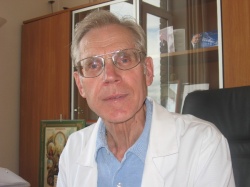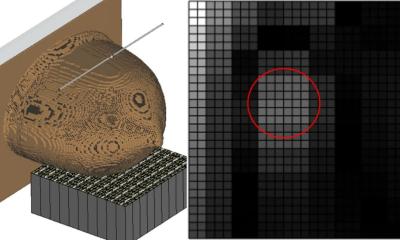Oncologists gather for ‘white nights’ in St Petersburg
Olga Ostrovskaja reports
White nights in St Petersburg draw in not only romantics, but June in this beautiful city also sees thousands of delegates arrive to attend the many scientific conferences and congresses. Among oncologists, the ‘white nights’ period means another annual scientific conference organised by the NN Petrov Research Institute of Oncology. For its continuing focus on breast cancer, the halls are packed.


European Hospital discussed this important event in the oncology calendar with the Chairman of the Scientific Organising Committee, Vladimir Semiglazov MD, who is also head of surgery at NN Petrov Research Institute of Oncology, in St Petersburg, Chairman of the Society of Oncologists of St Petersburg and the Leningrad region, and corresponding member of RAMS.
Asked why breast cancer is an annual focus, Vladimir Semiglazov explained that oncologists come from almost all of Russia, as well as other countries, because diagnoses and treatments are developing rapidly and doctors need to keep abreast of new data. ‘Not all of them can read foreign publications and Russian journals don’t have the latest data and are only published six times a year. Practitioners should be aware of trends in breast cancer diagnosis and treatment, the successes and failures.’ Similar conferences are held in other cities, he pointed out, ‘…but our lecturers are always top people in their countries -- and doctors know that.’
Breast cancer diagnosis and treatment is slow in development, he pointed out. ‘There are a million new cases of breast cancer in the world annually. In the USA the proliferation of this form of cancer has reached epidemic proportions, affecting one in every seven American women, and the US invests seriously in fundamental research. Russia has spent almost nothing on science. Although we have too high a morbidity: more than 50,000 new cases are registered and 24,000 women die annually.’
Within scientific hypotheses regarding the causes of breast cancer, one this is clear, Dr Semiglazov said, ‘Tumours are hormone-dependent and it’s believed the main "culprit" is oestrogen, which is produced in the ovaries. Hence, prevention and treatment associated with anti-oestrogens.’
Referring to a large study conducted in the USA and Britain and involving 30,000 at risk women (persistent recurrence of the disease in direct relatives, long-term benign processes, lack of birth, etc), he said: ‘Half of the women are simply observed and had a mammogram, while another group took anti-oestrogenic drugs. Over the years it became clear that, among the treated women, the incidence of cancer was reduced by 50%. It would seem a huge success! However, reduction in the frequency of relatively favourable tumours, which are so well treated, did not determine mortality. But hormone-independent difficult-to-treat cancers are not amenable to prevention. Moreover, such chemoprophylaxis increased the incidence of cancer of the uterine endometrium. Although the reduction of breast cancer was higher than the growth of endometrial cancer, but individually it is difficult to predict the possible prognosis. Therefore, this approach to prevention was not recommended.’
The second route, now being researched in Britain and at the NN Petrov Research Institute of Oncology, is the use of aromatase inhibitors -- drugs that reduce oestrogen levels. ‘About 4,000 women have already been included in this study; recruitment of 8,000 more is necessary.’
Screening, but…
‘Russia has declared that the country’s screening programme is running and there are 1,500 mammography centres. I’ve lectured in almost all the cities where, according to officials, a screening programme has begun - Tomsk, Kemerovo, Nizhny Novgorod, and Barnaul. I’ve been shown a huge number of mammographs, but seen mainly enormous tumours -- doctors only confirm the diagnosis that a woman came to them with herself.
‘However, for screening to detect tumours -- when neither doctor nor woman can see anything, when the tumour is not palpable, when the surgeon doesn’t see it and needs to be shown the image for exact tumour size and location – we need special equipment, stereotactic biopsy machines. However, apart from Moscow and St Petersburg, not one region with a screening programme has this technology.
‘Only if all the screening conditions in the programme can be met -- more than 60% of appointments kept, monthly monitoring by each physician etc. as well as quality control in the X-ray, laboratory, radiology (whether radiologists read the information correctly), pathomorphology (whether the pathomorphologists understand the disease), surgery (monitoring the surgeon’s work) – could we talk of a decline in mortality after seven years. And that’s providing that, with the detection of small tumours, we simultaneously have all the features of adequate treatment.
‘Incidentally, the first stages of financial investments in screening programmes are costs for tumour treatments, and only seven years later is it possible to record a four-fold reduction in costs: in the first stage of a cancer only minimally invasive surgery is needed.’
So, is it a fallacy to open a screening centre in 2010 and claim that mortality will fall in 2012? ‘Certainly. We could wait for results in 2017, but I think that’s unlikely. I can hardly imagine it will be easy to get even at-risk Russian women (say, over 50 years) to come regularly for a mammogram. Special programmes should be developed to work with the public. Finland, for example, has developed special computer software that calculates the time of a woman’s next visit for a mammogram and then she and her relatives are posted a reminder and asked to explain any reason for not attending.
‘It’s a very important “nuance” and officials who develop a programme simply do not know it and should consult with experts. Also, the number of mammographs is not so important. According to the International Agency for Cancer calculations, our country would be very well-equipped 500 mammography centres – not 1500! Problem number one: Proper organisation. When I speak to radiologists about screening I face a storm of indignation: ‘We aren’t going to work for nothing!’ They see 100,000 surveys to identify 200 cases of early stage breast cancer. Yes, 99,800 images will be "clean", but that’s the idea of screening: to study and tell the woman she is healthy and need have no concern for two more years.
‘Oncologists need this information very much -- when I went to the regions I lectured from early morning to evening that they need modern drugs in the right quantities and radiologists’ assistance. In many Russian areas the first and second are big problems, and sometimes the only route they can take is to send patients for treatment in Moscow or to us. That’s why it’s so important to prevent breast cancer.’
07.09.2010











